Chris Bojrab ’89 – Brain Biology
Psychiatrist Chris Bojrab ’89 presented Brain Biology and Behavior Before the Big Bash where he provided an introductory look at the advances in the understanding of neurobiology – the relationship between brain physiology and mood, anxiety, cognition, sleep, and pain.
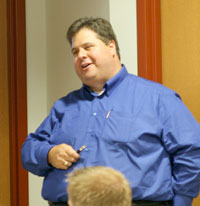 Bojrab began with some fun facts about the organ scientists know so little about – the brain. The brain contains approximately 100 billion neurons with between 1,000 and 3,000 synapses each which means there are between three and four quadrillion opportunities for information exchange.
Bojrab began with some fun facts about the organ scientists know so little about – the brain. The brain contains approximately 100 billion neurons with between 1,000 and 3,000 synapses each which means there are between three and four quadrillion opportunities for information exchange.
If compared to the specs of a super computer, the brain is able to perform 10 quadrillion operations per second with a minimum storage of 1,000 terabytes of information or, as Bojrab said, "1.8 million years of DVD quality video."
While the brain only accounts for two percent of our bodies mass, it accounts for twenty percent of the bodies energy.
Bojrab discusses the neurotransmitters in the brain – what each of them do and the side effects. He explained that while there are medications that can alter the different neurotransmitters, individuals vary significantly so no medication will react exactly the same in any two people.
The understanding of brain physiology has evolved throughout history. Now there is a great understanding of how genetics play a role in depression, anxiety, and addiction.
The Teaching and Scholarship of W. Norwood Brigance
See a photo album from the colloquium here.
Valerie Harvey-Powell ’59 – Integrating Medical and Dental Records
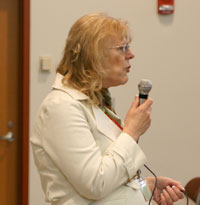 Valerie Harvey-Powell ’59 discussed optimizing the model of health care and health information technology through integrating medical and dental records.
Valerie Harvey-Powell ’59 discussed optimizing the model of health care and health information technology through integrating medical and dental records.
"Currently medical records and data exist separate and distinct from dental records and data," Powell said. "There are many potential intersections in which the medical records can inform the treatment of dental problems and vice versa. Unfortunately, there is no systematic information exchange at these intersections. This leads to a number of problems."
Powell has traveled the country and presented her findings and recommendations to many groups in order to get some attention on the issue. She said, "Having two streams of care is not a recipe for patient safety and quality of care."
Stephen Miller ’64 – The Nemean Games
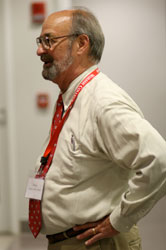 Stephen Miller ’64 received his PhD from Princeton in Classical Archeology and began work as the director of a dig in Nemea, Greece focusing on the site of the Stadium of Nemea and looking for clues about the Nemean Games. His research has contributed to knowledge of ancient Greece and Greek athletics, as well as the modern revival of those games where participants from around the world step into history.
Stephen Miller ’64 received his PhD from Princeton in Classical Archeology and began work as the director of a dig in Nemea, Greece focusing on the site of the Stadium of Nemea and looking for clues about the Nemean Games. His research has contributed to knowledge of ancient Greece and Greek athletics, as well as the modern revival of those games where participants from around the world step into history.
In July, 1974, after nearly ten months of digging, the group had still uncovered nothing at the stadium dig site. Miller recalled working with a student who was to log all the findings from that dig. She had nothing to do. Her last week there on the fifth and final day of the workweek they found the starting line of the track.
As digging continued for several years Miller uncovered the water channel, seating areas, an undressing area (the athletes competed in the nude), and most notably in 1992 the intact tunnel connecting the undressing area to the stadium.
In 1995, as a result of Miller’s work, locals formed the Society for the Revival of the Nemean Games. In 1996 the first revival games were held with competitors from all around the world. The games continue to take place every four years.
Miller ended his presentation to a packed room saying, "My interest in archeology that led to these discoveries and revival of the games began here in the fall of 1960."
Doug Sparks '69 – Growing Sunset Cellars
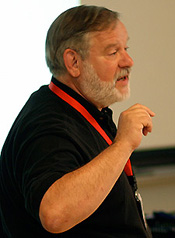 Doug Sparks makes one thing clear when talking about his small California winery: what he does is nothing like Napa Valley!
Doug Sparks makes one thing clear when talking about his small California winery: what he does is nothing like Napa Valley!
Sparks walked a big crowd through the wine making process and shared how he wants he wines to be different than others with a personal style. He shared several slides putting his 2,000 case-a-year winery in perspective compared to many other California operations.
He recently opened a shared tasting room in the Suisun Valley where he bases his operation. The Suisun Valley sits on the south end of Napa.
But the highlight for the many alumni attending was tasting Doug's Suisun Valley and Dry Creek Zinfandel along with two vintages of his award-winning Barbera.
He talked briefly about wine shipping laws and how he has been frustrated for years unable to find an Indiana distributor to carry his wines. But he keeps trying and hopes to have his wine in Indiana shops soon. He recently picked up a distributor in Wisconsin.
His wines can be ordered from his Sunset Cellars website.
Michael Bricker ’04—The Dome Project: Architecture as Activism
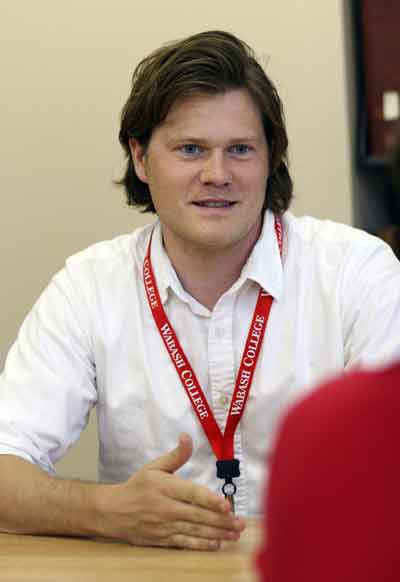 Michael Bricker earned his degree in architecture in Texas, he’s designed a house in Mongolia, and was recently in California promoting a movie for which he’d been production designer. But Bricker’s work may have its greatest impact right here in his home state of Indiana.
Michael Bricker earned his degree in architecture in Texas, he’s designed a house in Mongolia, and was recently in California promoting a movie for which he’d been production designer. But Bricker’s work may have its greatest impact right here in his home state of Indiana.
Ray Jovanovich ’84—America's Challenge and Wabash
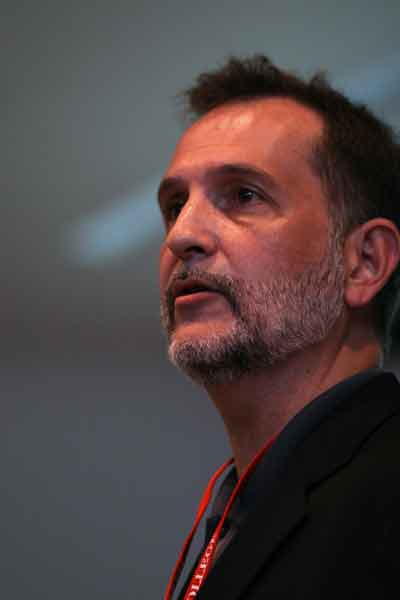 Residing in Hong Kong for the past 15 years as director and chief investment officer in Asia for the eighth largest retail banking group in the world, Ray Jovanovich ’84 has had a front row seat to the extraordinary economic advance of China, India, and Southeast Asia.
Residing in Hong Kong for the past 15 years as director and chief investment officer in Asia for the eighth largest retail banking group in the world, Ray Jovanovich ’84 has had a front row seat to the extraordinary economic advance of China, India, and Southeast Asia.
But at his colloquium on Saturday, before discussing those economies and their impact on the future of the United States, Jovanovich spoke about where his career really began.
"Wabash was my Event Horizon," he said. "It all started here with my inaugural visit to campus."
Jovanovich read from a passage he'd written to honor his father, who died two years ago:
"My father was quick to recognize the significance of this place; a man who was basically illiterate when he was liberated by General Patton’s Third Army in the spring of 1945 after having spent 50 months in prison, captured early on during Hitler’s march across Europe.
"But his was a life rich in experience, and during our Parent’s Day farewell talk that warm August afternoon in 1984, he encouraged and admonished me to absorb as much as possible here. He proclaimed that Wabash would provide the foundation for my long road ahead."
That long road has taken him to Credit Agricole Asset Management’s Asia office, from which he travels throughout Southeast Asia looking for investment opportunities and studying economic trends. From those travels and analyses he sees both a bright economic future and plenty of challenges for China and India.
And he sees dark clouds on the horizon for the U.S. workers, not only from competition with these countries, but from what he deems the "greatest and gravest national security threat to the U.S.—the crumbling public education system across America.
"From Hong Kong I have the occasional opportunity to lecture in schools and universities in China and to meet students from India," Jovanovich said. "The tenacity, aptitude, and hunger of these students is impressive."
Jovanovich contrasted "well-prepared kids" of China and India, with "an astonishing sense of entitlement" he often sees in students in America.
"As if they have all of this coming to them," he added, pointing out the low test scores in math and science throughout the U.S. and the fact that our "chronic deficit of engineers in America necessitates importing talent."
"This is why Wabash and places like it are so important, especially when you look at the competition that’s coming.
"I grew up in Northwest Indiana; nobody knows better the impact of losing jobs and an entire industry," Jovanovich said. He added that "the achievement gap has to be reversed. We can’t accept it. The clock is running."
Denis Kelly ’84: "Holy Lands—Journeys of a Pilgrim Artist"
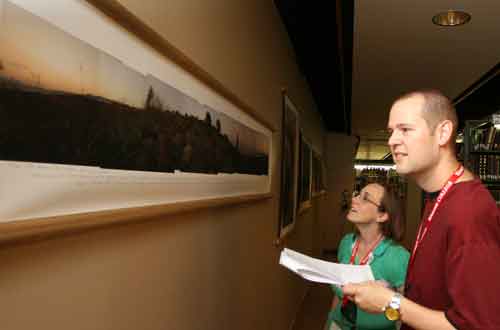 An alumnus gazing at three photographs by Denis Kelly ’84 from his exhibit "Holy Lands: Journeys of a Pilgrim Artist," seemed puzzled by the grouping—Machu Pichu, the lost city of the Incas; the twin towers of the World Trade Center; the Amazon river flowing through Peru.
An alumnus gazing at three photographs by Denis Kelly ’84 from his exhibit "Holy Lands: Journeys of a Pilgrim Artist," seemed puzzled by the grouping—Machu Pichu, the lost city of the Incas; the twin towers of the World Trade Center; the Amazon river flowing through Peru.
"Denis sure has an interesting way of putting photographs together," the man said, still trying to figure out how these three were related, and how any of them could be considered "holy lands," as the exhibit’s title suggested.
The answer to his question is to be found in Kelly’s vision, informed now by travels to four continents as he "seeks out people of prayer and places of special "Holiness."
"Recently I was part of a Franciscan-led pilgrimage group in Israel/Palestine—the Holy Land," Kelly writes. "The notion of THE Holy Land is provocative. Can all of creation be considered a Holy Land?"
For Kelly, clearly, much of creation is holy ground, and in his pilgrimage over 25 years he’s endeavored to see not only the holy places of his own Christian faith, but to see holy places through the eyes of those of different faiths and beliefs.
You can see the exhibit online at www.deniskelly.com
In photo: Lisa and Rob Walker ’99 enjoy the "holy lands" of Denis Kelly's exhibit.